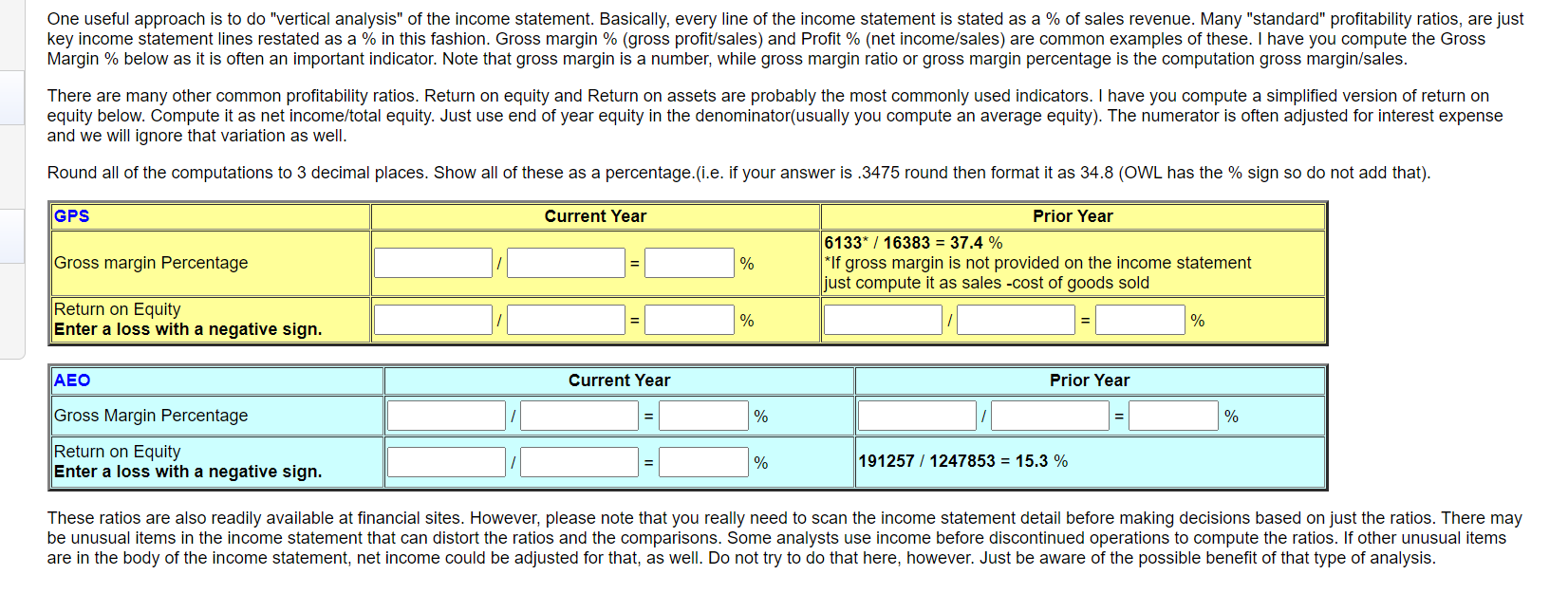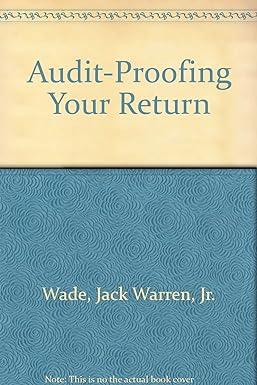Question
GPS Current Ratio = Current Assets / Current Liabilities Current Year = $4568 / $2461 = 1.856 Previous Year = $4315 / $2453 = 1.759

GPS Current Ratio = Current Assets / Current Liabilities Current Year = $4568 / $2461 = 1.856 Previous Year = $4315 / $2453 = 1.759
Debt/Asset % = Total Liabilities / Total Assets x 100 Current Year = ($2461+2384) / $7989 x 100 = 60.6% ($2453+2253) / $7610 x 100 = 61.8%
AEO Current Ratio = Current Assets / Current Liabilities Current Year = $968530 / $485221 = 1.996 Previous Year = $901229 / $493783 = 1.825
Debt/Asset % = Total Liabilities / Total Assets x 100 Current Year = ($485221+84301) / $1816313 x 100 = 31.3% ($493783+84308) / $1782660 x 100 = 33.4%
One useful approach is to do "vertical analysis" of the income statement. Basically, every line of the income statement is stated as a % of sales revenue. Many "standard" profitability ratios, are just key income statement lines restated as a % in this fashion. Gross margin % (gross profit/sales) and Profit % (net income/sales) are common examples of these. I have you compute the Gross Margin % below as it is often an important indicator. Note that gross margin is a number, while gross margin ratio or gross margin percentage is the computation gross margin/sales. There are many other common profitability ratios. Return on equity and Return on assets are probably the most commonly used indicators. I have you compute a simplified version of return on equity below. Compute it as net income/total equity. Just use end of year equity in the denominator(usually you compute an average equity). The numerator is often adjusted for interest expense and we will ignore that variation as well. Round all of the computations to 3 decimal places. Show all of these as a percentage.(i.e. if your answer is .3475 round then format it as 34.8 (OWL has the % sign so do not add that). GPS Current Year Prior Year 6133* / 16383 = 37.4 % *If gross margin is not provided on the income statement just compute it as sales -cost of goods sold Gross margin Percentage % Return on Equity Enter a loss with a negative sign. % % AEO Current Year Prior Year Gross Margin Percentage % % Return on Equity Enter a loss with a negative sign. % 191257 / 1247853 = 15.3 % These ratios are also readily available at financial sites. However, please note that you really need to scan the income statement detail before making decisions based on just the ratios. There may be unusual items in the income statement that can distort the ratios and the comparisons. Some analysts use income before discontinued operations to compute the ratios. If other unusual items are in the body of the income statement, net income could be adjusted for that, as well. Do not try to do that here, however. Just be aware of the possible benefit of that type of analysis. One useful approach is to do "vertical analysis" of the income statement. Basically, every line of the income statement is stated as a % of sales revenue. Many "standard" profitability ratios, are just key income statement lines restated as a % in this fashion. Gross margin % (gross profit/sales) and Profit % (net income/sales) are common examples of these. I have you compute the Gross Margin % below as it is often an important indicator. Note that gross margin is a number, while gross margin ratio or gross margin percentage is the computation gross margin/sales. There are many other common profitability ratios. Return on equity and Return on assets are probably the most commonly used indicators. I have you compute a simplified version of return on equity below. Compute it as net income/total equity. Just use end of year equity in the denominator(usually you compute an average equity). The numerator is often adjusted for interest expense and we will ignore that variation as well. Round all of the computations to 3 decimal places. Show all of these as a percentage.(i.e. if your answer is .3475 round then format it as 34.8 (OWL has the % sign so do not add that). GPS Current Year Prior Year 6133* / 16383 = 37.4 % *If gross margin is not provided on the income statement just compute it as sales -cost of goods sold Gross margin Percentage % Return on Equity Enter a loss with a negative sign. % % AEO Current Year Prior Year Gross Margin Percentage % % Return on Equity Enter a loss with a negative sign. % 191257 / 1247853 = 15.3 % These ratios are also readily available at financial sites. However, please note that you really need to scan the income statement detail before making decisions based on just the ratios. There may be unusual items in the income statement that can distort the ratios and the comparisons. Some analysts use income before discontinued operations to compute the ratios. If other unusual items are in the body of the income statement, net income could be adjusted for that, as well. Do not try to do that here, however. Just be aware of the possible benefit of that type of analysisStep by Step Solution
There are 3 Steps involved in it
Step: 1

Get Instant Access to Expert-Tailored Solutions
See step-by-step solutions with expert insights and AI powered tools for academic success
Step: 2

Step: 3

Ace Your Homework with AI
Get the answers you need in no time with our AI-driven, step-by-step assistance
Get Started


